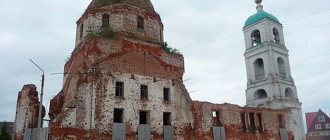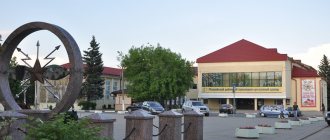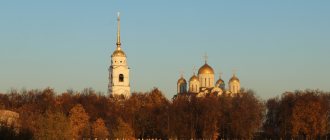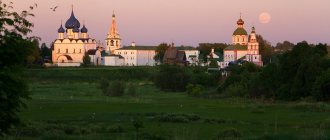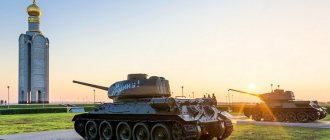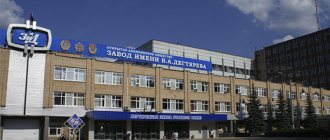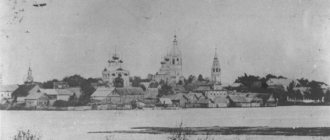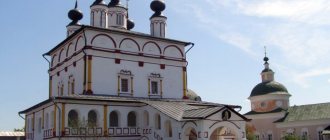Why have I always been attracted to the sights of Murom and its environs? As long as I can remember, I always wanted to visit the monasteries of Murom, visit the relics of the holy princes Peter and Fevronia, and watch the sunsets over the Oka River.
Over the course of several years, this desire intensified, and only in 2013 did it finally mature so much that all the circumstances around it worked out in the best possible way for this trip.
The Internet has provided a bunch of varied information about the sights of the city of Murom and its immediate surroundings. In the city itself with its 150 thousand population alone there are 4 monasteries and many temples. Murom itself is located on the high bank of the beautiful Oka River.
The path ahead was not long, so I wanted to visit as many interesting places as possible, but I also wanted, after all, not just to run through monasteries and churches, but to “live” (or at least “be”) there a little. Alas, time, as always, turned out to be short... But this is not a reason to be sad! The first impression is good. But now you can repeat your route more “thoughtfully” and additionally visit places you haven’t been to yet.
We plan to spend 3 days and 2 nights in Murom. If we take into account the long journey from my hometown of Obninsk, Kaluga region, then, in fact, we only have one full day left (most of the remaining days will be taken up by road). But we don’t want to waste this time, so we explore what other attractions we can visit along the way.
So, we are planning a route : Muromtsevo (the abandoned estate of Count Khrapovitsky), a geyser (natural fountain) near Sudogda, the city of Murom (with its numerous monasteries, temples, holy relics, miraculous icons, springs), Holy Lake in Dedovo (Navashinsky district, Nizhny Novgorod region).
We are traveling in a female group of 4 people: three Natalyas and Yulia. Opel Corsa car. Departure is scheduled for Friday, August 2 at 9 a.m....
Follow the following links to start your journey!
You can also download the full trip description to your computer or phone. Click the button to take the guide with you!
Ilya Muromets
The most famous native of the Murom land is the epic hero Ilya Muromets, repeatedly mentioned in folklore not only of Russians, but also of neighboring peoples. The apparent contradiction of the previous sentence is deceptive. Many researchers consider Ilya Muromets to be a real historical character. And the collective story of his life is simply amazing. Everyone has heard about the hero’s exploits for the glory of the Russian land. But some details of his biography are not so well known.
The grandfather of Ilya Muromets was a convinced pagan. Once, in a fit of anger, he chopped up a Christian icon with an ax. The punishment fell on his grandson: Ilya could not walk since childhood, and all attempts to heal him were unsuccessful. The boy could only train his arms: his legs rested lifelessly on the stove. This continued until the age of 33 (the age of Christ!). Two “kalik passersby” (wandering beggars) entered his house and asked him to give them “intoxicating beer.” Ilya took their request as a mockery and said so. But the strange Kaliki were not embarrassed and repeated the request, which sounded more like an order.
Ilya, unexpectedly for himself... stood up and fulfilled the request. But the Kaliki did not drink, but ordered Ilya to do so, who after this felt great strength within himself. This can't happen? I agree, with only one addition: if we consider only the visible physical world to really exist. After all, the “Kalikas” who visited Ilya were...Christ with one of his apostles (as it was written in the pre-revolutionary editions of the epic about Ilya Muromets).
At the end of his life, Ilya Muromets decided to devote himself to God. He became a monk of the Kiev-Pechersk Monastery under the name of Elijah of the Pechersk. His relics rest in the Near Caves of the Lavra. Their study, conducted in 1988 by a commission of the Ministry of Health of Ukraine, gave results confirming the epic descriptions.
The relics belonged to a very physically strong man, approximately 50 years old, 1m 77 cm tall (in the 12th century, the average male height did not exceed 165 cm). He did suffer from polio in his youth, and his bones showed signs of many battles and blows with swords and spears, broken ribs and broken collarbones. Researchers named the cause of death as a blow to the chest from a sword or spear. It is assumed that this happened during the capture of Kyiv by Prince Rurik, when the Pechora Lavra was destroyed by the Polovtsians who were part of the prince’s army. In 1643, the Monk Ilya Muromets became a saint of the Russian Orthodox Church.
Village Karacharovo
The former village of Karacharovo is now a microdistrict of Murom. Its main attraction is house number 279 on the street. Priokskaya, where the hero was born and lived. Those living here today have no doubt that they are his direct descendants. Nearby is the Trinity Church, founded by the hero himself. The dilapidated building is now being restored, its bell tower with the chapel of Ilya Muromets has been restored.
Trinity Church
A nearby holy spring with a bath began to flow from the blow of the hooves of Ilya’s mighty horse.
Holy spring with bath
Annunciation Monastery Murom
Initially in the 12th century. on this site there was a wooden temple in which the spreaders of Christianity in Murom, princes Konstantin, Mikhail and Fedor, were buried. In honor of the capture of Kazan in 1553, Tsar Ivan the Terrible founded the Annunciation Monastery and the cathedral of the same name. The latter underwent a thorough reconstruction in the middle of the 17th century. The walls and baths of the monastery were also renewed in 1811. During the Patriotic War of 1812, the icons of the Iverskaya and Vladimir Mother of God were hidden in the monastery.
Annunciation Monastery Murom
Unlike many other churches, the closure of the monastery in 1919 can be considered conditional: the monks who moved to the city continued to serve there, and the relics of the saints were moved to local museums. During Soviet times, the Annunciation Cathedral in Murom was the only one functioning. The best 6-tier baroque iconostasis that has survived to this day also preserves icons from the 16th century. The entire monastery became fully operational again in 1991.
The icon of St. Elijah of Murom with a fragment of his relics is kept in the monastery, which was returned to believers in post-Soviet times and is still functioning.
Address - st. Krasnoarmeyskaya (formerly Uspenskaya), 16.
Annunciation Monastery and the miraculous Iveron Icon of the Mother of God
And next to the women's Holy Trinity Monastery, right across the road, is the men's Annunciation Monastery.
We were very interested in comparing these 2 places, which are located very close. It turned out that you experience different sensations inside.
This ancient monastery has its own saints and miraculous icons. And again it’s amazing: the relics (of princes Constantine, Mikhail and Theodore of Murom) rest in a single coffin.
The ancient miraculous icon of the Iveron Mother of God is also kept here. See details here.
Spaso-Preobrazhensky Monastery Murom
This monastery is one of the oldest and most famous in Rus'. According to documentary evidence, at the end of the 11th century. the son of Vladimir Monomakh was buried in it. The monastery arose around the estates of the first Murom prince Gleb. The initially wooden monastery was destroyed and burned by the Tatar-Mongols.
In the middle of the 14th century. the monastery was restored in stone. Two centuries later, the Transfiguration Cathedral was built nearby. Since then it has not undergone significant changes. During sieges, the cathedral assumed the functions of a fortress. Its facade is characterized by some severity, and its interior – asceticism.
Spaso-Preobrazhensky Monastery Murom
Another feature of the facade is the helmet-shaped (and not onion-shaped, as usual) domes. Subsequently, the monastery complex was replenished with the Church of the Intercession of the Virgin Mary with five chapels, a bell tower, a rectory, a religious school and outbuildings. Prince Peter, who accepted the schema, lived here, as is recalled by the bas-relief where he is depicted together with Fevronia, and the icon with scenes from their Life.
In 1918, the monks were accused of helping the White Guards, and the monastery was closed. Part of the monastery property became an exposition of the city museum. The premises of the monastery housed a factory, then a military unit.
In the 90s, the monastery was returned to believers. Now here, at the address st. Lakina, 1, there is a functioning monastery. In 2006, it was replenished with the image of Ilya of Muromets, made by a local carver according to the parameters obtained from studying the relics of Ilya of Pechersk.
Holy Trinity Monastery Murom
This convent on the site of a wooden church was built in the mid-17th century. financed by a local wealthy merchant. Its ensemble includes the five-domed Trinity Cathedral and the Kazan Gate Church with a bell tower.
Their interiors are decorated with tiles with images of herbs, birds and animals. The church and bell tower were erected on a single foundation. The slits of the facade and the lace decor give them lightness and airiness. The frames of many icons are decorated with skillful embroidery by gold-embroidery nuns.
Holy Trinity Monastery Murom
The monastery is primarily known as the burial place of the married couple of the Murom princes Peter and Fevronia, a monument to whom is installed in front of the entrance. Fevronia lived here after her monastic tonsure.
In worldly life, the princely married couple Peter and Fevronia won the love of their subjects with their righteous lives. They refused to help anyone, suppressed anger and cruelty, did not strive for worldly wealth, and glorified the name of God.
Peter and Fevronia, who naturally became monks in their old age, prayed daily to die at the same time and be buried in the same coffin with a thin partition. This was made during their lifetime. After Peter and Fevronia actually died on the same day and hour, their bodies were nevertheless placed in separate coffins in different monasteries, considering joint burial to be contrary to monastic traditions.
However, the next morning it turned out that the separate coffins were empty, and the bodies of Peter and Fevronia were reunited in the common coffin they had prepared. The next attempt to separate them after death was again unsuccessful. The people reconciled themselves to the will of God, and the couple were buried in the Nativity of the Mother of God Cathedral of the monastery. During the Soviet years it was closed, and the remains of the princes were transferred to the local museum. But the monastery was protected as an architectural monument. Since 1993, the relics returned to the church have been kept in the Trinity Cathedral.
Monument to Peter and Fevronia of Murom
The memory of the blessed princes Peter and Fevronia is celebrated annually on July 8. Since 2008, this date has been considered the Day of Family, Love and Fidelity. Wedding processions of newlyweds come to the monument to Peter and Fevronia every day in the hope that their marriage will be just as strong.
Since 1975, on the territory of the monastery there has been a wooden church of St. Sergius of Radonezh, transported from a nearby village, an architectural monument of the 18th century. It operates only in the summer. Since 2001, the Nadezhda boarding house has been opened at the monastery for minor girls and the elderly. The current address of the monastery is Peasant Square, 3 A.
Optional on topic
Recommended reading
